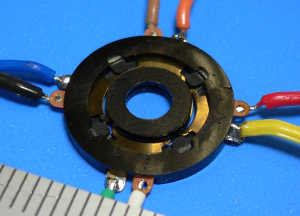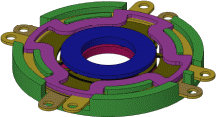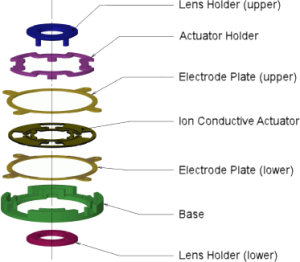 Polymer "muscle" offers stabilization potential
Polymer "muscle" offers stabilization potential
By
Mike Tomkins
(Tuesday, August 15, 2006 - 23:52 EDT)
Osaka, Japan-based tech startup Eamex Corp. has developed an extremely compact new optical image stabilizer device targeted at use in camera phones.
The prototype module is just 14mm across and 1.5mm thick. Inside, the company has crafted a 12mm polymer actuator with a mass of just 0.024 grams, sandwiched between two electrode plates that provide for power - and hence control. Two lens holders and packaging surround this. As a current is passed between the electrode plates (and hence through the actuator), the shape of the polymer changes so as to tilt the lenses up to 2.9° from their centered position, in two planes. (The process can perhaps be visualized as somewhat similar to the way our own muscles provide power by changing shape).

The prototype device has a drive voltage of +/-4V, and consumes just 0.015 to 0.035W of power. The lens can be moved at up to a maximum of 14.13° per second (within the boundaries of the 5.8° total movement available in each plane, of course). A video on Eamex's site shows a prototype with a laser reflector mounted in place of the topmost lens, giving a nice demonstration of the device's abilities.

Given their small size, optical image stabilizers have generally proven unsuited to the size and power constraints presented in camera phones. However, camera phones have severe limitations on sensor size / light sensitivity, flash strength, and ergonomics that tend to make them even more prone to camera shake than a regular digicam - so there's a clear need for a device that meets these challenges.
It isn't immediately clear from the materials on the company's site whether the design would scale up for use with the larger sensors and lenses used in most compact digital cameras or camcorders. Eamex's new device certainly looks to show great promise in the cameraphone arena, however. One further note is that Eamex also offers focusing and zoom mechanisms based on polymer actuators.

|